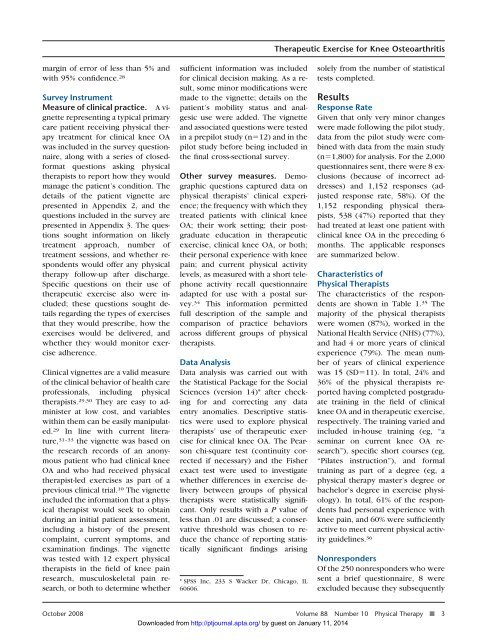Physical Therapists' Use of Therapeutic Exercise for Patients With ...
Physical Therapists' Use of Therapeutic Exercise for Patients With ...
Physical Therapists' Use of Therapeutic Exercise for Patients With ...
Create successful ePaper yourself
Turn your PDF publications into a flip-book with our unique Google optimized e-Paper software.
<strong>Therapeutic</strong> <strong>Exercise</strong> <strong>for</strong> Knee Osteoarthritis<br />
margin <strong>of</strong> error <strong>of</strong> less than 5% and<br />
with 95% confidence. 28<br />
Survey Instrument<br />
Measure <strong>of</strong> clinical practice. A vignette<br />
representing a typical primary<br />
care patient receiving physical therapy<br />
treatment <strong>for</strong> clinical knee OA<br />
was included in the survey questionnaire,<br />
along with a series <strong>of</strong> closed<strong>for</strong>mat<br />
questions asking physical<br />
therapists to report how they would<br />
manage the patient’s condition. The<br />
details <strong>of</strong> the patient vignette are<br />
presented in Appendix 2, and the<br />
questions included in the survey are<br />
presented in Appendix 3. The questions<br />
sought in<strong>for</strong>mation on likely<br />
treatment approach, number <strong>of</strong><br />
treatment sessions, and whether respondents<br />
would <strong>of</strong>fer any physical<br />
therapy follow-up after discharge.<br />
Specific questions on their use <strong>of</strong><br />
therapeutic exercise also were included;<br />
these questions sought details<br />
regarding the types <strong>of</strong> exercises<br />
that they would prescribe, how the<br />
exercises would be delivered, and<br />
whether they would monitor exercise<br />
adherence.<br />
Clinical vignettes are a valid measure<br />
<strong>of</strong> the clinical behavior <strong>of</strong> health care<br />
pr<strong>of</strong>essionals, including physical<br />
therapists. 29,30 They are easy to administer<br />
at low cost, and variables<br />
within them can be easily manipulated.<br />
29 In line with current literature,<br />
31–33 the vignette was based on<br />
the research records <strong>of</strong> an anonymous<br />
patient who had clinical knee<br />
OA and who had received physical<br />
therapist-led exercises as part <strong>of</strong> a<br />
previous clinical trial. 10 The vignette<br />
included the in<strong>for</strong>mation that a physical<br />
therapist would seek to obtain<br />
during an initial patient assessment,<br />
including a history <strong>of</strong> the present<br />
complaint, current symptoms, and<br />
examination findings. The vignette<br />
was tested with 12 expert physical<br />
therapists in the field <strong>of</strong> knee pain<br />
research, musculoskeletal pain research,<br />
or both to determine whether<br />
sufficient in<strong>for</strong>mation was included<br />
<strong>for</strong> clinical decision making. As a result,<br />
some minor modifications were<br />
made to the vignette; details on the<br />
patient’s mobility status and analgesic<br />
use were added. The vignette<br />
and associated questions were tested<br />
in a prepilot study (n12) and in the<br />
pilot study be<strong>for</strong>e being included in<br />
the final cross-sectional survey.<br />
Other survey measures. Demographic<br />
questions captured data on<br />
physical therapists’ clinical experience;<br />
the frequency with which they<br />
treated patients with clinical knee<br />
OA; their work setting; their postgraduate<br />
education in therapeutic<br />
exercise, clinical knee OA, or both;<br />
their personal experience with knee<br />
pain; and current physical activity<br />
levels, as measured with a short telephone<br />
activity recall questionnaire<br />
adapted <strong>for</strong> use with a postal survey.<br />
34 This in<strong>for</strong>mation permitted<br />
full description <strong>of</strong> the sample and<br />
comparison <strong>of</strong> practice behaviors<br />
across different groups <strong>of</strong> physical<br />
therapists.<br />
Data Analysis<br />
Data analysis was carried out with<br />
the Statistical Package <strong>for</strong> the Social<br />
Sciences (version 14)* after checking<br />
<strong>for</strong> and correcting any data<br />
entry anomalies. Descriptive statistics<br />
were used to explore physical<br />
therapists’ use <strong>of</strong> therapeutic exercise<br />
<strong>for</strong> clinical knee OA. The Pearson<br />
chi-square test (continuity corrected<br />
if necessary) and the Fisher<br />
exact test were used to investigate<br />
whether differences in exercise delivery<br />
between groups <strong>of</strong> physical<br />
therapists were statistically significant.<br />
Only results with a P value <strong>of</strong><br />
less than .01 are discussed; a conservative<br />
threshold was chosen to reduce<br />
the chance <strong>of</strong> reporting statistically<br />
significant findings arising<br />
* SPSS Inc, 233 S Wacker Dr, Chicago, IL<br />
60606.<br />
solely from the number <strong>of</strong> statistical<br />
tests completed.<br />
Results<br />
Response Rate<br />
Given that only very minor changes<br />
were made following the pilot study,<br />
data from the pilot study were combined<br />
with data from the main study<br />
(n1,800) <strong>for</strong> analysis. For the 2,000<br />
questionnaires sent, there were 8 exclusions<br />
(because <strong>of</strong> incorrect addresses)<br />
and 1,152 responses (adjusted<br />
response rate, 58%). Of the<br />
1,152 responding physical therapists,<br />
538 (47%) reported that they<br />
had treated at least one patient with<br />
clinical knee OA in the preceding 6<br />
months. The applicable responses<br />
are summarized below.<br />
Characteristics <strong>of</strong><br />
<strong>Physical</strong> Therapists<br />
The characteristics <strong>of</strong> the respondents<br />
are shown in Table 1. 35 The<br />
majority <strong>of</strong> the physical therapists<br />
were women (87%), worked in the<br />
National Health Service (NHS) (77%),<br />
and had 4 or more years <strong>of</strong> clinical<br />
experience (79%). The mean number<br />
<strong>of</strong> years <strong>of</strong> clinical experience<br />
was15(SD11). In total, 24% and<br />
36% <strong>of</strong> the physical therapists reported<br />
having completed postgraduate<br />
training in the field <strong>of</strong> clinical<br />
knee OA and in therapeutic exercise,<br />
respectively. The training varied and<br />
included in-house training (eg, “a<br />
seminar on current knee OA research”),<br />
specific short courses (eg,<br />
“Pilates instruction”), and <strong>for</strong>mal<br />
training as part <strong>of</strong> a degree (eg, a<br />
physical therapy master’s degree or<br />
bachelor’s degree in exercise physiology).<br />
In total, 61% <strong>of</strong> the respondents<br />
had personal experience with<br />
knee pain, and 60% were sufficiently<br />
active to meet current physical activity<br />
guidelines. 36<br />
Nonresponders<br />
Of the 250 nonresponders who were<br />
sent a brief questionnaire, 8 were<br />
excluded because they subsequently<br />
October 2008 Volume 88 Number 10 <strong>Physical</strong> Therapy f 3<br />
Downloaded from http://ptjournal.apta.org/ by guest on January 11, 2014
















